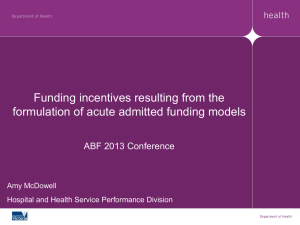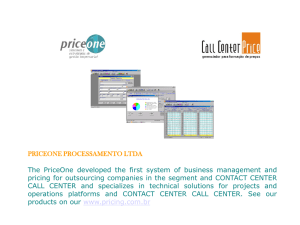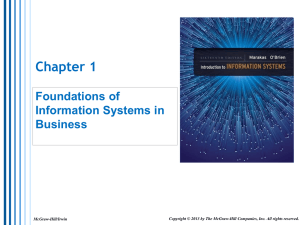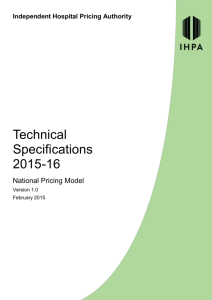Dr Trent Yeend, Senior Advisor, Pricing & Funding, IHPA
advertisement
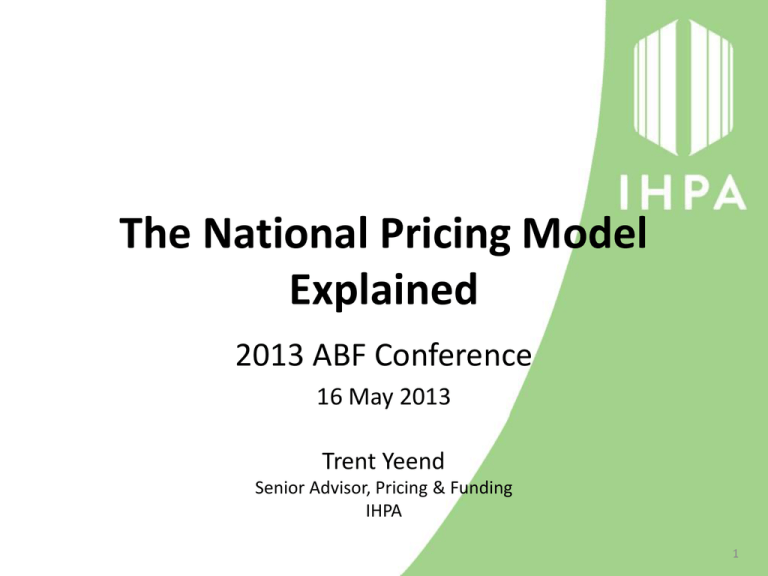
The National Pricing Model Explained 2013 ABF Conference 16 May 2013 Trent Yeend Senior Advisor, Pricing & Funding IHPA 1 Overview of workshop 1. ABF and the National Health Reform Agreement 2. Introduction to the National Pricing Model 3. Introduction to the National Cost Model 4. Transformation of National Cost Model to National Pricing Model 5. National Pricing Model by service category 6. Application of the National Pricing Model 2 §1 Activity Based Funding and the National Health Reform Agreement 3 ABF and the NHRA Under the National Health Reform Agreement, the role of the national efficient price is to: a. form the basis for the calculation of the Commonwealth funding contribution; and b. provide a relevant price signal to States and Local Hospital Networks. - Clause B11 4 ABF and the NHRA Two features of role (a) in ABF: 1. Volumes of (price) weighted activity at the Local Hospital Network (LHN) level are used to proportionally allocate each state/territory’s Commonwealth funding among their LHNs. 5 ABF and the NHRA Two features of role (a) in ABF: 2. Growth in price and activity over time are used to determine growth in Commonwealth funding over time. • Commonwealth funds 45% of growth from 2013-14 to 2016-17, then 50% of growth from 2016-17 onwards. 2013-14 45% 2014-15 45% 2015-16 45% 2016-17 50% 2017-18 50% 2018-19 50% ... CFx – Commonwealth funding in year x Px – Price in year x Vx – Volume in year x CF2 = CF1 + 45% (P2 V2 – P1 V1) 6 ABF and the NHRA Other features of the NHRA: 1. Scope of services 2. Private patients 3. Other Commonwealth programs 7 §2 Introduction to the National Pricing Model 8 The National Pricing Model The National Pricing Model provides the means by which IHPA prices hospital services. It comprises three parts: National Pricing Model National Efficient Price (NEP) Price Weights Adjustments Combine to define the National Weighted Activity Unit (NWAU) Price of hospital service = NEP × NWAU 9 The National Pricing Model Price Weights Adjustments • Define a measure of relative price across all in-scope activity. • Are defined across the classification systems within each service category. • Are used to modify price relativities to account for legitimate and unavoidable variations in the costs of service delivery. Price Weights Non-Admitted Emergency Subacute Activity Acute Adjustments Weighted Activity (NWAU) 10 The National Pricing Model Price Weights Adjustments 1 2 3 4 5 6 7 Acute admitted care Subacute & non-acute admitted care Emergency care Non-admitted care Mental health care 1. Paediatric 2. Specialist Psychiatric 3. Indigenous 4. Remoteness 5. ICU 6. Private Patient Service 7. Private Patient Accommodation 11 The National Pricing Model National Efficient Price (NEP) • Converts NWAU to price ‒ The NEP is the price of 1 NWAU ‒ Price = NEP x NWAU volume • Measures year on year change in mean price ‒ Based on mean price of in-scope acute admitted activity ‒ Excludes changes in mean price caused by changes in activity profile (ie. case-mix change). 12 The National Pricing Model Change in NEP and change in Price Weights YEAR 1 NEP YEAR 2 Change in NEP Price Weights NEP Price Weights Non-Admitted Emergency Subacute Acute Non-Admitted Change in Price Weights Emergency Subacute Acute 13 The National Pricing Model Example: Change in Price Weights vs Change in Price Price Weights I61A M63Z E62C 2012-13 3.3272 0.3789 0.7785 2013-14 3.2545 0.3787 0.7915 change -2.2% -0.1% 1.7% 2012-13 2013-14 change $4,808 $4,993 3.8% direction NEP I61A M63Z E62C prices 2012-13 2013-14 $15,997 $16,250 $1,822 $1,891 $3,743 $3,952 change 1.6% 3.8% 5.6% direction 14 The National Pricing Model This relationship extends to NWAU: For a fixed ‘basket’ of activity, after converting the activity to NWAU using two years’ pricing models, the following can be said: 1. NWAU increases aggregate price has grown at a rate greater than the growth in NEP 2. NWAU remains constant aggregate price has grown in line with growth in NEP 3. NWAU decreases aggregate price has grown at a rate less than the growth in NEP relative change (eg. 5% growth expressed as 105% change, -2% growth expressed as 98% change) Property: For fixed activity, (% change in NWAU) × (% change in NEP) = % change in aggregate price. 15 §3 Introduction to the National Cost Model 16 The National Cost Model • The National Pricing Model is based on cost and activity data from three years prior; eg. the 2013-14 pricing model is based on 2010-11 cost and activity data. • The cost and activity data for each of the historical years are used derive the National Cost Model for that year. • The National Cost Model is designed to ensure that the total model costs are equalised with the estimated total actual costs across ABF establishments. 17 The National Cost Model • The cost model is made up of cost parameters and adjustments: – paediatric adjustment, – specialist psychiatric age adjustment, – indigenous adjustment, – remoteness area adjustment, – and ICU adjustment • The private patient service and private patient accommodation adjustments do not form part of the cost model. – They are introduced in the pricing model to remove out of scope costs associated with private patients. 18 The National Cost Model Cost Parameters Adjustments • Define a measure of cost across all in-scope activity (cost profiles). • Are used to modify modelled costs to account for legitimate and unavoidable variations in the costs of service delivery. • Are defined across the classification systems within each service category The National Cost Model Cost Parameters Non-Admitted Emergency Subacute Activity Acute Adjustments Modelled cost of activity ($) 19 §4 Transformation of the National Cost Model to the National Pricing Model 20 Transformation of NCM to NPM There are three key differences between the National Pricing Model and the National Cost Model: 1. The pricing model comprises an NEP (ie. a reference cost), price weights and adjustments, whereas the cost model comprises cost parameters and adjustments. 2. The cost model is based on costs and activity three years prior to the year of the corresponding pricing model. 3. The pricing model excludes costs offset by revenue from other Commonwealth programs. 21 Transformation of NCM to NPM Cost Model Cost Parameters Adjustments 1. Derivation of a reference cost 2. Conversion of parameters to weights Cost Weight Model Reference Cost Cost Weights Adjustments 3. Removal of out of scope costs 4. Indexation to reflect costs in the year of the pricing model Pricing Model NEP Price Weights Adjustments 22 Transformation of NCM to NPM Step 1: Derivation of a reference cost • The reference cost is the precursor to the NEP. • The change in reference cost over time is ‘standardised’ to ensure it is not influenced by changes in activity profile (ie. case-mix change). – cf. standardised incidence/prevalence/mortality rates controlling for differences demographic/age profile. 23 Transformation of NCM to NPM Step 1: Derivation of a reference cost Year of activity data 2009-10 2010-11 $4,587 (B) (Z) (X) $4,489 (C) $4,260 (A) (Y) A – 2009-10 reference cost (= 2009-10 mean cost) X – crude growth rate of mean cost B – 2010-11 mean cost Y – standardised growth rate C – 2010-11 reference cost Z – ‘rebasing’ factor 24 Transformation of NCM to NPM Step 2: Conversion of parameters to weights • The parameters of the cost model are divided by the reference cost, converting the parameters to cost weights and transforming the cost model to a cost weight model. • The selection of reference cost in the previous step ensures that the two consecutive years’ cost weight models give the same total weighted volume when applied to the activity data on which the standardised growth rate is derived. 25 Transformation of NCM to NPM Step 3: Removal of out of scope costs Out of scope costs can be classified as follows: 1. Costs associated with out of scope activity, (eg. activity delivered to out of scope patient types such as DVA), and activity not regarded as from an in-scope service type (eg. out of scope Tier 2 non-admitted service types). 2. Proportions of costs associated with private patients that are offset by non-government and Commonwealth revenue. 3. Costs associated with other Commonwealth programs(eg. Highly Specialised Drugs program, Pharmacy Reform Agreements). 26 Transformation of NCM to NPM Step 3: Removal of out of scope costs 1. Group 1 costs are excluded by simply restricting the cost model to in-scope activity. 2. Group 2 costs are excluded through the implementation of the private patient service adjustment and private patient accommodation adjustment within the pricing model. 3. Group 3 costs are excluded by deflating them out of the cost model. 27 Transformation of NCM to NPM Step 4: Indexation • The final step is the indexation of costs to estimate those in the year of the pricing model. • To derive this indexation rate: 1. the cost model is applied retrospectively to the five years of patient costed acute admitted activity data up to the year of the cost model. 2. Scaling factors are calculated that adjust the cost model so that model costs are equalised with each year’s actual costs. 3. The trend of these scaling factors is then projected forward from the year of cost model to the year of pricing model. 28 Transformation of NCM to NPM Step 4: Indexation Illustration of scaling factors required to equalise model and actual costs Actual costs Model costs derived by applying cost model to costed activity data Historical Projected s2 sx Scaling factor required to equalise s s5= 1 model costs with actual costs s3 s4 s1 Year 1 Year 4 Year 5 Year 6 Year 7 Year 8 s1 s4 s5 s s2 s3 Time series Year of cost model Year of pricing model Projection of time series 29 Transformation of NCM to NPM · Derivation of reference cost · Conversion of cost parameters to cost weights Cost Model · Deflation to remove costs offset by funding from other Commonwealth programs · Indexation · Restriction to in-scope activity Cost Weight Model Pricing Model Reference Cost National Efficient Price Cost Weights Price Weights Adjustments Adjustments Cost Parameters Adjustments · Inclusion of private patient adjustments 30 §5 National Pricing Model by Service Category 31 National Pricing Model by Service Category • Activity is grouped into four streams (service categories) – Acute Admitted – Subacute and Non-Acute Admitted – Emergency – Non-Admitted – With mental health spanning all four streams • Classification systems are defined across all service categories, and the National Pricing Model defines prices over these classification systems. 32 National Pricing Model - Acute Admitted - 33 NPM – Acute Admitted • Classification: Australian Refined Diagnosis Related Groups (AR-DRGs) • DRGs are broken into price categories based on (ICU adjusted) length of stay: – same-day – short-stay outlier – inlier – long-stay outlier 34 NPM – Acute Admitted Episode Is the episode same-day? No Does the DRG have ICU unbundled? No Define ‘ICU-adjusted LOS’ as LOS Yes Does the DRG have a same-day price category No Yes Define ‘ICU-adjusted LOS’ as LOS minus whole eligible ICU days (ensuring a lower bound of 1 day) Price Category Same-day Yes Is ICU-adjusted LOS (strictly) less than DRG inlier lower bound? Yes Price Category Short-Stay Outlier Yes Price Category Inlier No Is ICU-adjusted LOS less than or equal to DRG inlier upper bound? No Price Category Long-Stay Outlier 35 NPM – Acute Admitted • There are seven episode-level adjustments: – paediatric adjustment – specialist psychiatric age adjustment – indigenous adjustment – remoteness area adjustment – ICU adjustment – private patient service adjustment – private patient accommodation adjustment 36 NPM – Acute Admitted Price Weight Table 37 NPM – Acute Admitted Price weights • Same-day price category makes use of same-day price weight • Short-stay outlier price category makes use of short-stay outlier base and per diem price weights • Inlier price category makes use of inlier price weight • Long-stay outlier price category makes use of inlier and longstay outlier per diem price weights 38 NPM – Acute Admitted Basic form of DRG price weight function price weight SD SSO Inlier LSO ICU-adjusted LOS 39 Price Weight function forms NPM – Acute Admitted Price Weight function Price Categories DRGs MDCs 19&20 Remainder Inlier 3 28 Inlier/LSO 0 230 SSO/Inlier/LSO 15 293 SD/Inlier 0 1 SD/Inlier/LSO 1 119 SD/SSO/Inlier/LSO 1 14 40 NPM – Acute Admitted Example of cost model DRG profile against actual costs and activity 41 NPM – Acute Admitted Application of adjustments PW Apply paediatric adjustment Apply ICU adjustment Apply specialist psychiatric age adjustment Apply private patient service adjustment and private patient accommodation adjustment Apply indigenous adjustment and remoteness area adjustment NWAU 42 National Pricing Model - Subacute & Non-Acute Admitted - 43 NPM – Subacute & Non-Acute Admitted • Classifications: – The Australian National Subacute and Non-Acute Patient (ANSNAP) Classification – Care Type • AN-SNAP classes are broken into price categories based on length of stay: – same-day – entire episode per diem – short-stay outlier – inlier – long-stay outlier 44 NPM – Subacute & Non-Acute Admitted Episode Is the AN-SNAP class same-day (referred to as ambulatory in description)? Yes Is episode LOS (strictly) less than AN-SNAP class inlier lower bound? Price Category Same-day Yes Price Category Inlier No No Are the AN-SNAP class inlier lower and upper bounds zero? Yes Price Category Short-Stay Outlier Yes Price Category Entire Episode Per Diem No Is episode LOS less than or equal to AN-SNAP inlier upper bound? No Price Category Long-Stay Outlier 45 NPM – Subacute & Non-Acute Admitted • There are five episode-level adjustments: – paediatric adjustment – indigenous adjustment – remoteness area adjustment – private patient service adjustment – private patient accommodation adjustment 46 NPM – Subacute & Non-Acute Admitted Price Weight Table 47 NPM – Subacute & Non-Acute Admitted Price Weights • Same-day price category makes use of episode price weight • Episode per diem price category makes use of outlier per diem price weight • Short-stay outlier price category makes use of outlier per diem price weight • Inlier price category makes use of episode and inlier per diem price weights • Long-stay outlier price category makes use of episode and inlier per diem and outlier per diem price weights 48 NPM – Subacute & Non-Acute Admitted Basic form of AN-SNAP price weight function price weight SSO Inlier LSO Episode LOS 49 NPM – Subacute & Non-Acute Admitted Price Weight function forms Price Weight function Price categories AN-SNAP classes Same-day 45 Inlier/LSO 13 SSO/Inlier/LSO 45 EpiPerDiem 24 50 NPM – Subacute & Non-Acute Admitted Application of adjustments PW Apply paediatric adjustment Apply indigenous adjustment and remoteness area adjustment Apply private patient service adjustment and private patient accommodation adjustment NWAU 51 National Pricing Model - Emergency - 52 NPM – Emergency • Classifications: – Urgency Related Groups (URGs) – Urgency Disposition Groups (UDGs) • There is one episode-level adjustment: – indigenous adjustment • A single price weight is defined for each URG and for each UDG. PW Apply indigenous adjustment NWAU 53 National Pricing Model - Non-Admitted - 54 NPM – Non-Admitted • Classification: – Tier 2 Non-Admitted Services Classification • There is one episode-level adjustment: – indigenous adjustment • A single price weight is defined for each in-scope Tier 2 Service class. PW Apply indigenous adjustment NWAU 55 §6 Application of the National Pricing Model 56 NWAU calculators • Available from the IHPA website • Microsoft Excel Workbooks • One for each service category 1. Copy & Paste activity data into appropriate Workbook – Input variables defined in Workbooks (incl. formatting) 2. Press button Validation Checks on input data Outputs NWAU value against each record 57 NWAU calculators Excel NWAU calculator – Acute Admitted Input variables required: 1. RecordID 9. Pat_SLA 2. Hosp_State 10. FundingSource 3. Hosp_RA06 11. LOS 4. Hosp_Level3ICU_Flag 12. Psych_Days 5. Hosp_Paed_Flag 13. ICUHours 6. Pat_AgeYears 14. SameDay_Flag 7. Pat_Indigenous_Flag 15. DRG6x 8. Pat_Postcode 58 NWAU calculators Excel NWAU calculator – Subacute & Non-Acute Admitted Input variables required: 1. RecordID 8. FundingSource 2. Hosp_State 9. Phase_LOS 3. Hosp_RA06 10. SameDay_Flag 4. Pat_AgeYears 11. ANSnapClass_v3 5. Pat_Indigenous_Flag 12. CareTypeCode 6. Pat_Postcode 7. Pat_SLA 59 NWAU calculators Excel NWAU calculator – Emergency • Two calculators: – URG version – UDG version • Input variables required: 1. RecordID 2. Pat_Indigenous_Flag 3. URG v1.3 Code / UDG v1.3 Code 60 NWAU calculators Excel NWAU calculator – Non-Admitted • Input variables required: 1. RecordID 2. Pat_Indigenous_Flag 3. Tier2_Clinic_Code 61 62

